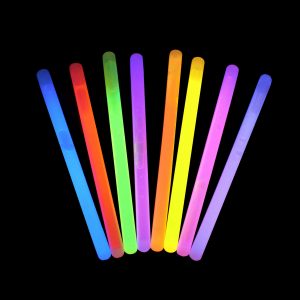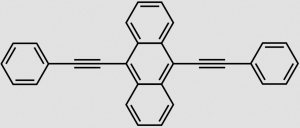Everybody knows those popular fluid-filled sticks that glow vividly in the dark. They’re popular at dances, raves, and other events. But what exactly is going on? How does bending the stick make them glow? What is even glowing in the first place?

Glow sticks may come in a variety of different colours. Credits: Glowtopia
Glow sticks rely on a property called chemiluminescence, where some of the energy released from a chemical reaction is emitted in the form of light. This energy is usually derived from the breakdown of hydrogen peroxide contained within a fragile tube inside the stick, which forms high-energy intermediates. [1]

9,10-bis(phenylethynyl)anthracene, a common green fluorescent dye. Credits: Wikimedia
This energy from the peroxide intermediates is then converted to visible light through the use of a fluorescent dye that emits photons at a specific wavelength. These fluorophores often contain many aromatic rings within them. The delocalized electrons in these aromatic rings are able to absorb the energy and jump into an excited state. When the electrons relax back to a lower energy state, they release energy in the form of light. [2]
In order to get different colours, glow stick manufacturers often mix different fluorescent dyes. This, combined with the wide range of fluorescent dyes available, allows for a wide variety of glow stick colours out there!
So the next time you wave a glow stick around, you can think about the interesting physics and chemistry that’s happening inside it! Or maybe you can try applying the chemistry to other domains, such as biology!
Sources:
[1] Fdez. Galván I, Gustafsson H, Vacher M. Chemiexcitation without the Peroxide Bond? Replacing Oxygen with other Heteroatoms. ChemPhotoChem. 2019;3(9):957-967. doi:10.1002/cptc.201800232
[2] Mitsui M, Kawano Y, Takahashi R, Fukui H. Photophysics and photostability of 9,10-bis(phenylethynyl)anthracene revealed by single-molecule spectroscopy. RSC Adv. 2012;2(26):9921-9931. doi:10.1039/C2RA21100A
